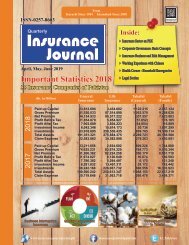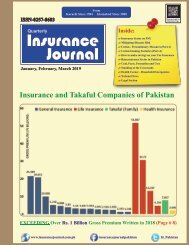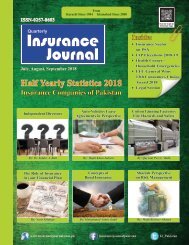Insurance Journal (4th Quarter 2020)
You also want an ePaper? Increase the reach of your titles
YUMPU automatically turns print PDFs into web optimized ePapers that Google loves.
Guest Contribution
example the property worth Rs.
100,000 is insured for Rs. 80,000/- A
loss, if arises, is estimated for Rs
.10,000/-, the insurer would pay only
Rs. 8,000/- by applying an insurance
term called the average condition used
to calculate a claim payment i.e.
formula
(80,000÷100,000x10,000=Rs.8,000/-)
Perils as described earlier can be
divided into three groups; insured,
excluded and uninsured perils. It is
possible that more than one peril takes
part leading to a loss. In this situation,
it could be difficult to find out the
main peril responsible for giving rise
to the loss. Here the insurance
principle of proximate cause guides to
establish the main cause of the loss. It
is worth noting that the proximate
cause always remains dominant
because of a direct link between it and
the loss. For example, a thunder
uproots a tree which falls on wiring
resulting in fire at the factory which
was controlled by water causing
damage to stocks. In this situation the
loss, if caused by uninsured or
excluded perils, is not payable. This
example is suggesting for adequate
coverage of risks against a number of
perils expected to threaten the insured
property.
In some cases the acceptance of the
risk is subject to application of
conditions and warranties attached
with policy documents. Conditions
include an excess, deductible and
franchise applied either by way of
imposing on the risk or offering a
discount in the premium depending on
the types of risks.
An excess usually applied on small
risks is the first amount of each and
every claim borne by the insured. A
deductible is similar to an excess but
very large amount applied generally
on a large industrial business. For
example, a fire policy has a deductible
of Rs. 100,000/-. In the case of loss for
Rs. 500,000/-, the insurer would pay
only Rs. 400,000/- and the insured
would bear Rs. 100,000/- being coinsurer
to share the risk to the extent of
the deductible amount.
A franchise means that no claim is
payable unless it exceeds the amount
or time franchise. Once the claim
exceeds the stated amount or time, the
entire amount of claim including
franchise is payable.
There are a large number of warranties
attached with the insurance policies to
safeguard the insured assets or
minimize the frequency of losses. For
instance, an insurance policy covering
the assets of Cotton Mills is issued
with the important warranties applied
with a view to protect the stocks of
cotton against fire.
It seems appropriate to describe some
other areas of a risk to be examined
before providing insurance coverage
to a risk.
As mentioned earlier that a risk must
be insurable in order to cover but there
are some risks which even meet this
criteria cannot be insured on a stand
alone basis. For example, a policy
against loss of profit can never be
issued in isolation. Loss of profit
policy is issued only in relation to the
property damage or machinery
breakdown insurance because
indemnification under this policy
would only be payable, if business
interruption is caused by physical loss
or damage under the respective policy.
There are two types of insurance
contracts in non-life insurance called
indemnity and benefit. The indemnity
means the insured must be able to
recover the actual loss amount neither
more nor less. For example the market
value of a car is Rs. 600,000/- but
insured with the insurance company
for Rs. 800,000/-. In the event of total
loss, the company will be responsible
to pay only Rs. 600,000/-. If the
insured has received Rs. 800,000/- it
would mean that the insured has
gained Rs. 200,000 which is against
the insurance principle of indemnity.
It would not be out of place to mention
here that in the case of car theft the
insurer obtains a letter of subrogation
from the insured at the time of claim
payment. The subrogation letter
means taking over the insured's rights
to exercise it as and when needed in
connection with recovery of the theft
car. One of the reasons to get this letter
is to prevent the insured from taking
any kind of benefits by way of
recovery of the theft car because he
has already been indemnified and
taking more than indemnity means
breaking the principle of indemnity.
The benefit policy is generally issued
covering the risk of personal accident
and sickness. As there is no
mechanism to estimate the loss of any
part of the body so the insurer pays
fixed benefits to the insured at the time
of losses.
It is possible that an item of the
insured is covered under more than
one policy. It generally happens due to
overlapping of policies or travel
insurance policy covering the same
item already covered under a house
insurance policy. In this situation the
insurance principle of contribution is
applied. It operates when the same
interest under double insurance gets
damaged and lost resulting from the
same peril. Here all insurers would
share the burden of claim in
proportion to the amount of loss. Take
the example of a laptop worth Rs.
30,000/- insured with two different
companies for the same amount. In the
case of theft of the laptop the rule of
contribution would apply and both the
companies make contribution equally
to make up the total loss of Rs.
30,000/-.
It is hoped the efforts made in
presenting the important steps taken
into account during the underwriting
process as well as analyzing the levels
of a risk along with covering all
general insurance principles will help
all together in leading towards a
prudent underwriting of insurance.
Insurance Journal October, November, December 2020
18
Find us at: www.insurancejournal.com.pk — www.facebook.com/insurancejournalpakistan

















